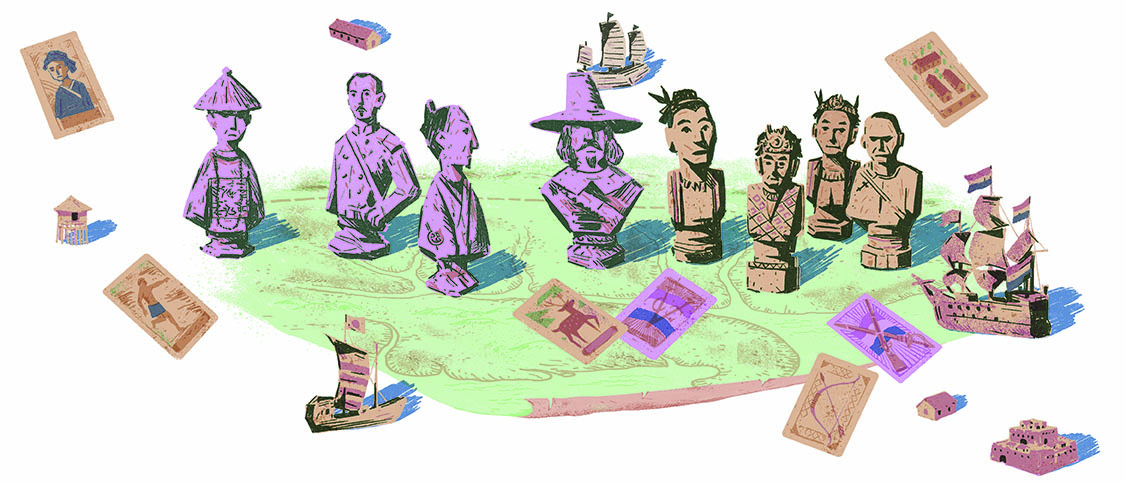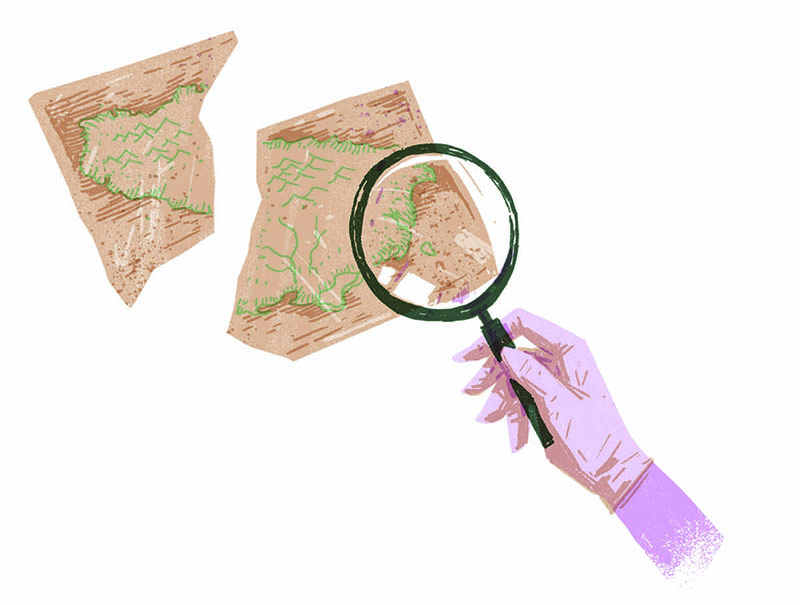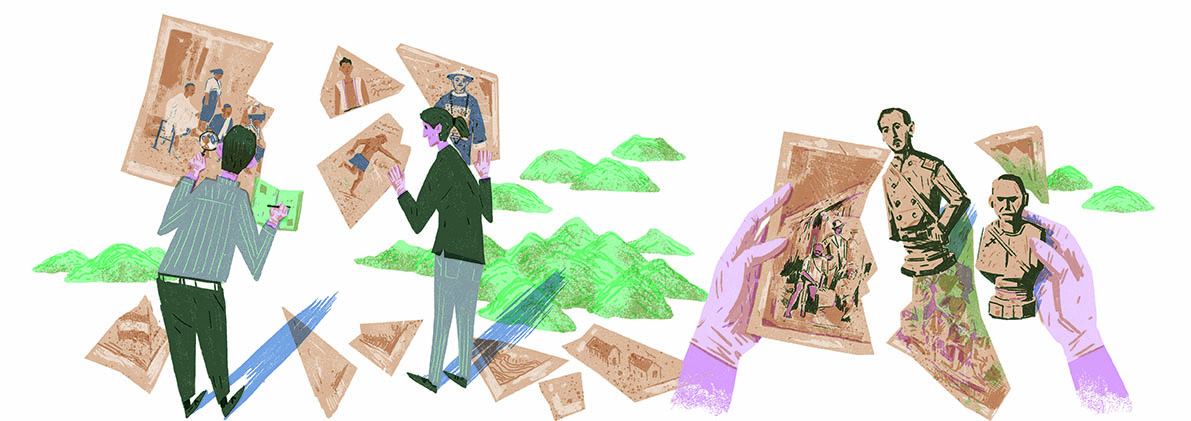Have you heard of the Kingdom of Tjaquvuquvulj in Southern Taiwan, the Tatuturo Confederation in Central Taiwan, and the 18 Lonckjau Indigenous Communities in Hengchun? These “strange” kingdoms actually existed on the island of Taiwan. The history of Taiwan before the 17th Century was not blank; the indigenous peoples of Taiwan developed a diverse history in their settlements, portraying the rich civilizations of Taiwan’s Confederation Era.。
In his book, Taiwanese History, Lien Heng states: “Before the Netherlands settlement, Taiwan had no history. Taiwanese history started with the Netherlands settlement, was developed further by Goxingga, and was continued by the Qing Dynasty.” For over 300 years now we have understood this version of Taiwanese history to be true. But is it? Was there any “confederation” or “kingdom” unknown to us coming into power?
According to literature reviews, before the Netherlands, there were various “indigenous political powers” in Taiwan. They were entities that possessed certain types of power or exerted influence. They were co-leaders of dozens of communities, community leaders or sea merchants, or leaders of pirate groups. They were commonly referred to as the “Kings.” That means before foreign political power came to Taiwan, there was the existence of confederations or community alliances. To some degree, they did command and control Taiwan.
In the 17th Century, the indigenous peoples of Formosa built diverse political powers, but after the arrival of the Vereenigde Oostindische Compagnie (VOC), colonial power was established by force to remove indigenous confederation and political power, reducing them to mere footnotes in Taiwan’s history.

The First King
Recognized by Japan
As shown in literature, Taiwan’s first “king” was Dika or Dijcka, a leader of the Siraya people of Xingangshe.
In 1624, the VOC conspired with local officials, businessmen, and pirates in China to “move” their operations to Tainan, which served as the beginning of the Netherlands era in Taiwan. This foreign political power invaded Taiwan with the motivation for colonial trade, which meant that the Siraya people settled in Xingangshe at that time who had already faced troubles brought by the Japanese and pirates, were further threatened by the intensive conflicts brought by the “red-haired hoan.”
From 1627 to 1628, trade conflicts occurred between the Netherlands and the Japanese. When the VOC negotiated with Edo Tokugawa Shogunate over tariff and trade, as interpreted by the Netherlands, a Japanese silk businessman named Hamada Yahyoue encouraged 16 members of the Siraya Community in Xingangshe and two Non-indigenous interpreters to form the “Taiwanese representative group” to go to Japan to visit Tokugawa Lemitsu. They protested the VOC on behalf of Taiwan, and they offered the “land” to show their loyalty to the Tokugawa Shogunate. Japan, thus, gave the title of “the King of Taiwan” to the Dika. This is the so-called “Hamada Yahyoue Incident.”
As the community leader of Xingangshe in the era of Taiwan’s invasion by international super powers, Dika became the first “King of Taiwan” to be crowned by Japan. Although the leader was not the king of all of the indigenous peoples of Taiwan, he was nonetheless recognized and honored “internationally.”
This historical story of the King of Taiwan actually describes an episode of Taiwan’s sovereignty dispute between the Netherlands and the Japanese in the 17th Century, which indicates the existence of community leaders among the indigenous communities.

The 18 Communities of Lonckjau
Holding the Rights to Levy Taxes and Sovereignty on the Hengchun Peninsula
During the Qing Dynasty, the Paiwan community - which is located in the north of Fenggang River in Southern Taiwan - was referred to as the Up 18 Communities of Lonckjau. It was later classified by the Japanese as the Neiwen Group of the Paiwan People or the Tjaquvuquvulj while the communities to the south of the Fenggang River were called Lonckjau The Down 18 Communities of Lonckjau, who were a Hengchun Group of Paiwan settlers mainly composed of the Seqalu people, descendants of Pinuyumayan and Paiwan people through mixed marriages. Generally, the 18 Communities of Lonckjau include the settlement areas of the four major communities of the Seqalu people and the surrounding Paiwan and Amis communities.
Compared to other kings of the same era in Taiwan, although Chief Lonckjau did not have the title of “king,” he nonetheless governed 18 communities and held the rights to levy taxes and sovereignty. He was able to appoint a leader for each community, and most notably, he had the exclusive right to kill community members.
However, after the arrival of the VOC, Chief Lonckjau surrendered and signed a treaty. He was deprived of the right to kill community members and to appoint community leaders. Taxes were levied by the Company from community members. The power of the Chief was surrendered, but community force still existed. The Chief Tooke-tok, played an important role in negotiating with the US, Japan, and the Qing government for the Rover Incident in 1867 and the Mudan Community Incident in 1874.
The Tjaquvuquvulj Kingdom
the First Austronesian Political Entity with an Initial Form of State
Among the known political sovereignties, the one closest to the form of state is the Tjaquvuquvulj Kingdom which is located in the high mountain area of Southeastern Taiwan that has its own land, people, sovereignty, diplomatic ties, and tax system.
The Tjaquvuquvulj Kingdom was established in Southern Taiwan long before the arrival of the VOC in the 17th Century. Some scholars even regard this as the first Austronesian political entity with the form of a state. Relevant literature indicated the existence of the Tjaquvuquvulj Kingdom before the Netherlands Era in Taiwan. Although no clear records can show the exact time of establishment of the Tjaquvuquvulj Kingdom, it had sufficient conditions to constitute a country in the sense that it was people ruled, sovereignty governed, land administered, and it had governance and finance systems.
Tjaquvuquvulj was originally the residence of two big chiefs. Geographically, it was the core area of the Tjaquvuquvulj Kingdom protected by its surrounding satellite communities. Hence, official records mostly used Tjaquvuquvulj to refer to this community. The name “Tjaquvuquvulj” indicates the core community of the area, a big “kingdom” that leads to the other communities.
The governing area of the Tjaquvuquvulj Kingdom was the settlement for Paiwan people. In the beginning, ten communities possessed different lands and were in conflict. Later, most communities surrendered to the Tjaquvuquvulj community and formed the governance of Chief.
The power structure and social system of the Kingdom were similar to that of the feudal systems in ancient China that were concerned with classes and ethics, co-production and co-sharing, gender equality, and military agriculture. According to historical records which cover several hundred years, the Kingdom made contact and negotiate with foreign powers such as the VOC, Koxinga power, the Qing Empire, and the Japanese colonial government. It had practical diplomatic relationship with its allies and indeed, was a kingdom.
In addition to the Tjaquvuquvulj Kingdom in the east, there was also the Pinuyumayan Community, led by the Pinuyumayan people.
The musician Baliwakes (also known as Lu Seng-Bao in Chinese and Mori takaraichiro in Japanese) who influenced Pinuyumayan music greatly, wrote a song named “the Pinuyumayan King” which described the great achievements of their ancestors, the Pinarai. Legend had it that the Pinuyumayan King led both the Pinuyumayan people, the Amis people and the Paiwan people in the neighborhood area. He exerted great political influence on Eastern Taiwan. In particular, after the first half of 17th Century, the Pinuyumayan Community maintained close relationships with foreign powers including the VOC, the Qing Dynasty, the Japanese government, and national government.
In 1638, under the assistance of the Lonckjau Chief, the Netherlands went to the Pinuyumayan area and used military threat to force the Pinuyumayan leader to surrender his governing ten communities to the VOC. Since 1640, official documents of the Netherlands have showed close contact with the Pinuyumayan communities. For example, when the Netherlands organized a meeting for communities in Southern Taiwan in Chikan in 1644, the noblemen and women from “Pimaba” (the Pinuyumayan communities) helped to explain the rules of Netherlands officials in their language. Furthermore, the annual convention in Eastern Taiwan has also been held in Pimaba since 1652.

The Kingdom of the Taiwanese Plains Indigenous Peoples,
and the Inter-racial and Inter-language Tatuturo Confederation
There were not only Paiwan and Pinuyumayan kingdoms, but also the Quataongh Kingdom which was established by the Taiwanese Plains Indigenous Peoples in Western Taiwan.
“The King of Quatongh” was referred to in recorded Netherlands Literature as the “Barbarian King(番王)”, who lived south of the border of the Dadu Plains. The “King” mentioned in the Netherlands literature did not have the equivalent meaning of the western concept, but was rather a figure that held special rights and status among his indigenous people.
“The King of Quatongh” governed the inter-ethnic and inter-language area and later, the area in governance was classified according to ethnic groups where the Barbarian King came from. With the help of the Papora Community, he ruled the Babuza, Pazehhe, Hoanya, and Taokas peoples. His ‘kingdom’ was mainly located along the Dadu River, which is today’s Taichung, Changhua, and Nantou.
Threatened by the strong Papora People, the VOC could not make its move to Northern Taiwan smoothly. It wasn’t until 1645 that the Netherlands sent its military to combat the Quatongh People and invaded 13 communities. The Quatongh King then led all communities to surrender to the VOC and signed the treaty. After that surrender, the King’s rights and status were surrendered and he had no power to resolve disputes between communities.
At the end of the Netherlands rule, the Quatongh Kingdom was semi-independent, and by the Ming Cheng Era, before surrendering, it fought fiercely. A riot occurred during the Emperor of Yongzheng in the Qing Dynasty because of heavy duties, and the Kingdom sent its military force to attack Changhua Provincial City. Finally, it was defeated by the Qing government. After this war, the Qutongh Kingdom lost its power completely and could not resist the political power of the Qing and Non-indigenous people’s settlements. The Qutongh then people moved to Puli and Yilan.

A Historical Confrontation?
Kings of Taiwan in the Age of Discovery
In general, mainstream history has posited that there were no political organizations of Taiwan’s indigenous peoples before the arrival of the Netherlands in Taiwan, and such narratives have been considered to be “Taiwanese History.” Chen Di who came along with Shen to Taiwan at the end of the Ming Dynasty to fight against the Japanese and “An Account of Eastern Barbarins” described Taiwan’s indigenous peoples as “diverse ethnic groups belonging to communities with several hundred to 1,000 people. There were no leaders; those with more children would take the lead and others would follow them.”
But interestingly, as with other historical literature, “An Account of Eastern Barbarians” has several problems and contradictions. It said that Taiwan had no chiefs but later stated: “The Japanese were defeated and Dayuan was recovered. The indigenous leader Damile led dozens of followers to visit. Deer and wine were offered for removing the evil.” The “barbarian leader” was of that community. Additionally, the Netherlands “Degh-Register gehouden int Costell Batavia” or “ De Dagregisters van het Kasteel Zeelandia” were also found to have discrepancies. According to the literature, “There were no leaders or chiefs among Taiwan’s indigenous peoples,” but in some articles, figures negotiating with the VOC include “leaders of Siraya communities”. Additionally, after 1644, a local parliament system was introduced by convening a meeting with leaders of Taiwan’s indigenous communities by the VOC. The Company also referred to community leaders of the Down Lonckjau of Paiwan and Up Sha Mo Hai Paiwan communities in Hengchun as “lords.”
We may be able to find reasons for these historical inaccuracies. After negotiating, foreign political power found that there was no power developed by Taiwan’s indigenous peoples that commanded the whole of Taiwan. Instead, they controlled different parts of Taiwan since they had community leaders.
The language and interpretation rights of historical writings are in the control of mainstream culture, and the history of Taiwan’s indigenous peoples has mostly been overlooked and forgotten. It is, thus, difficult to trace back and its history can only be reviewed from the perspective of “others” or even imagined as put together by the diverse social and political rights of Taiwan in the 17th Century.
The “king” referred to by foreign powers was not equivalent to that in the western concept, but he possessed certain power or influence close to that of confederation society or community alliance. These titles are the imaginations and records of outsiders towards others. Without concrete literature or proof, we are not able to determine whether or not the political powers during that time were confederations, alliances, or even kingdoms. Therefore, we should give more room to talk about Taiwan before and after the Era of Discovery to allow for all sorts of historical possibilities including the footprint of the confederation era on this island.
The Beauty and Sorrow of
“Confederation”

On the island of Taiwan, various types of states, ethnic groups, and political powers combined and tangled to form a complicated whole. In the past, we had either stereotypical impressions or a complete lack of understanding of Taiwanese history. There are several reasons for this: One is unclear official documentation, incorrect memories, and lack of written indigenous records. Most records were kept by and written from the perspectives of foreign powers, and no first-hand indigenous perspectives were presented.
Over the past two decades, scholars have continuously played a role in the studies of Taiwanese history, and have proposed not to discuss issues from only the perspectives of the Non-indigenous people. Perspectives of non-rulers shall be presented by collecting, interpreting, comparing and decoding the literature of different languages to gradually explore the mechanisms of Taiwan’s international trade which started during the Era of Discovery.
In more recent years, through the works of various domestic scholars such as Wong Jiayin and Kang Pei-te as well as international ones, we know that in addition to the kings of Paiwan and Pinuyumayan that ruled trans-ethnic groups and inter-communities or confederations, similar systems were implemented by the Taiwanese Plains Indigenous Peoples.
In his historical novel “A Tale in Three Tribes in Netherlands Formosa”, the retired M.D. and Professor Chen Yao-Chang from National Taiwan University portrayed the interaction, conflict, and integration between the Netherlands, Siraya people, and Non-indigenous people coming to Taiwan. His two historical novels, “Karisi Flowers” and “Lion Head Flowers,” described system decomposition or change in the 18 Lonckjau upper and lower Communities when impacted by foreign powers, to illustrate the internal social situation. His vivid way of writing created more historical re-imaginings of the great land of Taiwan.
When foreign political powers came to Taiwan, they brought new “civilizations” not known to Taiwan, and while exploiting their resources, the conflicts with the indigenous peoples on this land occurred that resulted in a fight for survival and cultural destruction. The rich and diverse indigenous cultures were homogenized, and new classes of colonization were created.
With historical language, more preservation is needed to prove the past existence of “confederations” or “kingdoms” in Taiwan due to insufficient documentation. In fact, the pursuit of the past presents an opportunity to restore culture. The existence of “imagined confederations” also reminds us that Taiwan’s historical discourse should have been studied much earlier than “the Netherlands settlement,” when inaccurate social cultures and perspectives were presented.

Please note that words of “barbarians” “uncivilized” used in this Issue only reflect to original texts used in the quoted historical literature and they do not contain any discrimination.
─ References ─
翁佳音,《異論臺灣史》,臺北:稻鄉出版社,2001年。
翁佳音,〈新港有個臺灣王-十七世紀東亞國家主權紛爭小插曲〉,《臺灣史研究》15:2,臺北:中央研究院臺灣史研究所,2008年。
康培德,《殖民想像與地方流變-荷蘭東印度公司與臺灣原住民》。臺北:聯經出版社,2016年。
陳耀昌,《傀儡花》,臺北:印刻出版社,2016年。
陳耀昌,《獅頭花》,臺北:印刻出版社,2017年。




